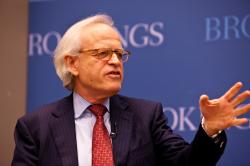With war, you know where it starts but the rest is unpredictable. With this in mind, on October 23, the Saban Center at Brookings conducted a “war game” simulation of American decision-making during a hypothetical invasion of Iraq. Utilizing former senior government officials and military officers, as well as several Middle East experts, the “war game” tested the interaction between competing political and military imperatives that could arise in the engagement with Saddam Hussein. In particular, it focused on actions Saddam might take to create problems for a U.S.-led Coalition in circumstances where the United States had only lukewarm international and regional support for an invasion. Among other issues, the game featured Iraqi terrorist and missile attacks on Israel, an effort to create chaos in Jordan, fighting between Kurds and Turks in northern Iraq (encouraged by Baghdad), and Iraqi terrorist threats against the United States and our allies.
With the deployment of an overwhelming force of nearly 300,000 troops, the U.S. “won” the war. However, under the constrained political circumstances in which the United States was forced to fight the war, Iraq’s counterattack efforts strained U.S. capabilities and created problems elsewhere in the region deleterious to U.S. interests. Above all the “war game” underscored the importance of having within the Administration an agreed political outcome clearly in mind before the President embarks on what will inevitably be an unpredictable venture.
GO SLOW OR FAST?
In the first stages of the simulation, American military and political leaders had different perspectives on the importance of a rapid advance on Baghdad. Initially, military leaders made this their highest concern; they stressed the need to employ all available forces to ensure a swift advance on Baghdad and resisted any diversion of forces to other missions as dangerous to the success of the primary goal of taking down the regime. In contrast, in the early stages of the war, the political leaders were far more willing to consider diverting U.S. forces to handle military missions that had important political ramifications—for example, deploying American troops to northern Iraq to keep the Kurds and the Turks from fighting, or deploying large U.S. ground forces to western Iraq to eliminate the threat of Iraqi Scud attack against Israel. They recognized that these diversions could come at the expense of the speed of the advance on Baghdad but believed this was justified by the need to prevent the military campaign from being derailed by political problems elsewhere in the region.
Once U.S. forces reached the outskirts of Baghdad, however, the political echelon changed its tune. With Baghdad surrounded and the final showdown with Saddam looming, the American political leadership made a rapid denouement its highest priority. Their assumption was that, at that point, the best and fastest way to solve most of the political problems created by the invasion and Saddam’s efforts to strike back, was to put the final nail in the regime’s coffin as quickly as possible, even at the expense of higher casualties. The American military leadership, while also keen to produce a rapid victory, was more cautious. Faced with the possibility of a tough battle in the streets of Baghdad (even though they were confident U.S. forces would not face a “Mesopotamian Stalingrad”), the military leadership presented an option for a more gradualist approach that slowly strangled Saddam’s remaining forces in Baghdad, and so minimized the number of U.S. and Iraqi civilian casualties. The political echelon decided for the rapid conclusion despite estimated losses of some 1,000 American and 5-10,000 Iraqi civilian casualties.
WHO RULES IN BAGHDAD?
With American forces at the gates of Baghdad, the war game highlighted a serious problem: once it became clear that Saddam was about to be toppled, the American team could reach no consensus about who should replace him, with different parts of the administration promoting their own candidates among the Iraqi exile opposition, defecting Sunni generals, or an American military occupation. In the scenario, a Republican Guard general offered to remove Saddam and save the American forces the trouble—a not unlikely scenario if Baghdad is surrounded by six coalition divisions. Because of disagreement among principles about who should rule in post-Saddam Baghdad, the general’s offer was turned down, rather than exploited. The President would be wise to resolve this issue before embarking on any Iraq venture.
FOR THE KURDS, NO FRIENDS BUT THE MOUNTAINS.
The simulation also revealed the vulnerability of Iraq’s Kurds to the maneuverings of Saddam, Turkey and Iran. The scenario employed in the simulation began with skirmishing between the Turks and the Iraqi Kurds (with clandestine Iranian support) in northern Iraq, as the Turkish army moved to ensure the Kurds did not take any major Iraqi cities in the north. Dependence on access to Incirlik and the lack of any ground forces in northern Iraq dictated U.S. reliance on diplomacy alone at a time when decision-makers were focused on other pressing problems. Tough words from Washington restrained both sides until an Iraqi action (the assassination of several Kurdish leaders, which all of the parties blamed on one another) caused this rough truce to break down and prompted the Kurds and Turks to begin a race for the major cities.
At that point, the American decision-makers unanimously concluded that U.S. interests lay principally with the Turks. Although initially, U.S. political leaders had been willing to consider deploying some ground forces to northern Iraq to keep both the Turks and Kurds in check, at that late date (when the gates of Baghdad were in sight) there was essentially no willingness to do so. In addition, the general sentiment was that the United States had warned the Kurds and used all of its diplomatic cards to restrain both sides. When those efforts proved inadequate, the importance of Turkey’s air bases to the operation and its status as a U.S. NATO ally trumped all other considerations. The players assumed that Turkey could be persuaded to withdraw once Saddam’s regime had been toppled and arrangements made to prevent the Kurds from asserting independence.
SHOULD THINGS GO WRONG, THE SAUDIS WILL BE IMPORTANT.
The simulation assumed that Riyadh granted the U.S. grudging use of its air space and acquiescence in the military access provided by other Gulf Arab states but refused the use of its air bases or territory for any ground operations. These conditions created considerable difficulties for the U.S. when problems arose both with Israel and Jordan. In Jordan, the simulation posited that the invasion sparked large-scale unrest among the Palestinian population (in part stoked by Iraqi agitators and the severing of Iraq’s economic ties to Jordan). At that point, Special Forces personnel operating out of eastern Jordan to hunt for Scuds in western Iraq became a liability for King Abdullah’s government, but the U.S. had little other choice because these forces could not operate out of Saudi Arabia and Kuwait was too far away to support them.
Similarly, the scenario assumed that U.S. air and special forces assets would not be able to suppress Iraqi Scud launches against Israel altogether (although they did greatly reduce the launches compared to 1990-91). As a result, Israel pressed the U.S. to deploy a large ground force to western Iraq to bolster this effort. While the American political leadership was willing to consider such a shift of resources, the military echelon resisted the diversion of resources from the main attack on Baghdad. However, the issue was decided on practical grounds: it was impossible to move ground forces to western Iraq without staging them from Saudi Arabia or Jordan and the Jordanians would not go along because of internal strife.
THE BIGGER THE BETTER.
The simulation also underscored the need for a massive invasion force. Because the simulation was intended to test the impact of a certain set of potential political-military developments on the conduct of an invasion of Iraq, it also held other variables constant. In particular, the scenario minimized the problems that Coalition military forces would likely encounter fighting Iraqi regular Army units on their way to Baghdad, providing for the humanitarian needs of the Iraqi people in those areas of the country liberated by the advancing Coalition forces, and dealing with bypassed Iraqi units or other forces purposely left behind by Saddam to disrupt a U.S. advance. Even under those permissive circumstances the nearly 300,000-man force that the Coalition employed was stretched thin in handling all of the different military, political, and humanitarian missions it was forced to conduct simultaneously. This strongly indicated that attempting to mount the invasion with a small ground component could result in far-reaching political problems, and the more ground forces available (including large numbers of civil-affairs personnel) the better the outcome for U.S. interests.
THE DOG THAT DID NOT BARK.
Although the American policy-makers in the simulation spent considerable time debating how to respond to an Iraqi WMD attack, the Iraqi terrorist attacks using anthrax against the United States and other Western countries had the least impact on U.S. decision-making in the simulation. The scenario posited a very aggressive Iraqi terrorism strategy, and granted these operations a sophistication and destructive capability that Iraq is not known to possess. Nevertheless, even under these circumstances, Iraq’s terrorist operations did not significantly affect how the United States conducted the war. The American decision-makers explicitly noted that they understood that an Iraqi terrorist counteroffensive was a likely outcome of an invasion and this was something that the U.S. had to expect and be ready to absorb if we opted to invade. Because the attacks did not cause massive casualties, and because the regime’s demise was imminent when they occurred, the American decision-makers decided that the best U.S. response was to press harder to complete the military victory.
OVERALL CONCLUSIONS.
The Iraq War simulation illustrated the important interaction between political and military considerations in a future invasion of Iraq. While the United States and its allies will have an overriding military goal (defeat Saddam’s military and overturn the regime), Washington will also have numerous, important political goals that will impinge on—and possibly even dictate—certain military operations. The Middle East region is politically fragile, and ensuring that an invasion does not cause harm to the interests of our allies in the region (in particular Jordan, Israel and Turkey) may necessitate attention to military considerations other than the primary drive on Baghdad. Likewise, the reconstruction of Iraq after Saddam’s fall will be critical in determining the extent to which such a war contributes to U.S. security and regional stability over the long term. For this reason, military operations will also have to be conducted as much with an eye toward creating the best conditions for the “day after” as they will for the rapid achievement of the immediate goal of eliminating Saddam’s regime.




